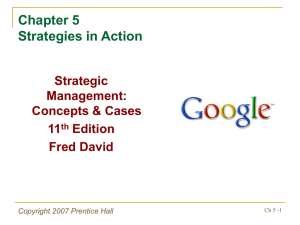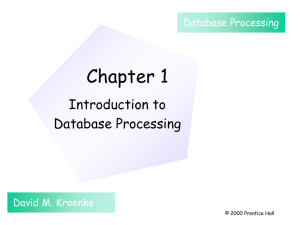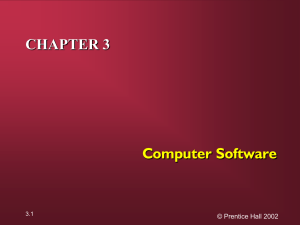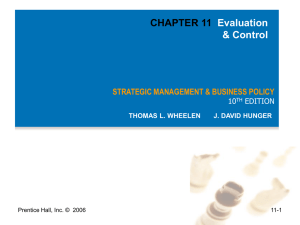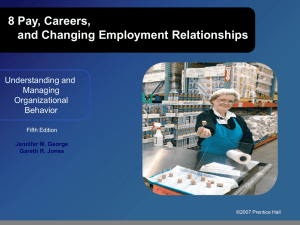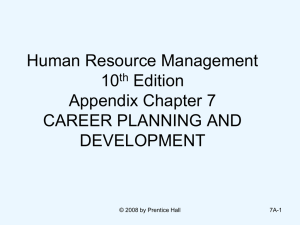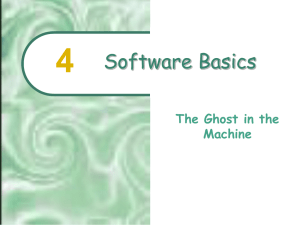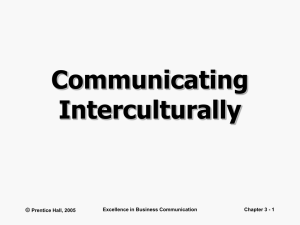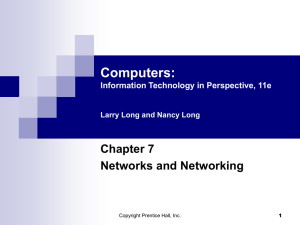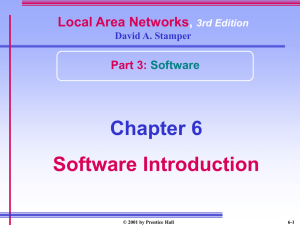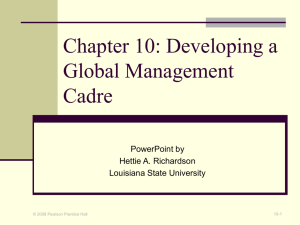Computers Are Your Future
advertisement
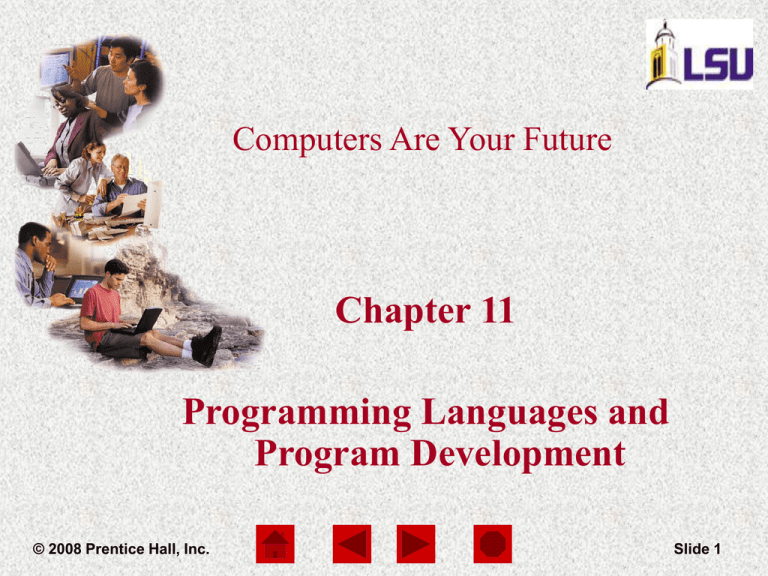
Computers Are Your Future Chapter 11 Computers Are Your Future Chapter 11 Programming Languages and Program Development © 2008 Prentice Hall, Inc. Slide 1 Computers Are Your Future Chapter 11 Programming Languages Assembly Language Machine Language Fortran Pascal BASIC Ada COBOL Visual Basic Smalltalk C and C++ Java Programming languages are artificial languages created to tell the computer what to do. They consist of vocabulary and a set of rules with which to write programs. The program development life cycle (PDLC) is an organized method of software development. © 2008 Prentice Hall, Inc. Slide 2 Computers Are Your Future Chapter 11 Development of Programming Languages Programming languages are classified by levels or generations. Lower-level languages are the oldest. The five generations of programming languages are: Machine languages Assembly languages Procedural languages Problem-oriented languages Natural languages © 2008 Prentice Hall, Inc. Slide 3 Computers Are Your Future Chapter 11 First-Generation Languages Machine language: Consists of Binary Numbers (0s and 1s) Is the earliest programming language Is the only language the computer understands without translation Is machine dependent - Each family of processors has its own machine language. © 2008 Prentice Hall, Inc. Slide 4 Computers Are Your Future Chapter 11 Second-Generation Languages Assembly language: Resembles machine language Is a low-level language Uses brief abbreviations for program instructions Abbreviations are called mnemonics A program is written in source code (text file) and translated into machine language by an assembler. © 2008 Prentice Hall, Inc. Slide 5 Computers Are Your Future Chapter 11 Third-Generation Languages Procedural languages: Are high-level languages that tell the computer what to do and how to do it Create programs at a high level of abstraction Are easier to read, write, and maintain than machine and assembly languages Use a compiler or interpreter to translate code Fortran and COBOL are third-generation languages. © 2008 Prentice Hall, Inc. Slide 6 Computers Are Your Future Chapter 11 Compilers and Interpreters A compiler is a program that changes source code to object code. An interpreter translates source code one line at a time and executes the instructions. © 2008 Prentice Hall, Inc. Slide 7 Computers Are Your Future Chapter 11 Third-Generation Languages (continued) Spaghetti Code and the Great Software Crisis GOTO statements resulted in programs that were difficult to follow. This problem led to the software crisis of the 1960s. Programs were not ready on time. Programs exceeded their budgets. Programs contained too many errors. Customers were not satisfied. © 2008 Prentice Hall, Inc. Slide 8 Computers Are Your Future Chapter 11 Third-Generation Languages (continued) Structured programming languages: Were developed to improve software development Include Algol and Pascal Forbid the use of GOTO statements Use control structures IF-THEN-ELSE © 2008 Prentice Hall, Inc. Slide 9 Computers Are Your Future Chapter 11 Third-Generation Languages (continued) Modular programming languages: Were developed because of problems in structured programming languages Are used to create programs that are divided into separate modules Each module carries out a special function. Require specified input to produce specified output © 2008 Prentice Hall, Inc. Slide 10 Computers Are Your Future Chapter 11 Fourth-Generation Languages Types of fourth-generation languages include: Report generators Languages for printing database reports Query languages Languages for getting information out of databases Fourth-generation languages are nonprocedural. They do not force programmers to follow procedures to produce results. © 2008 Prentice Hall, Inc. Slide 11 Computers Are Your Future Chapter 11 Fifth-Generation Languages Natural language would be the ultimate nonprocedural language. Despite years of effort, computers are still not good at understanding and acting upon natural language. Advances in speech recognition may provide a breakthrough for the development of natural language interfaces. © 2008 Prentice Hall, Inc. Slide 12 Computers Are Your Future Chapter 11 Object-Oriented Programming (OOP) Relies on component reusability The ability to produce program modules that perform a specific task Eliminates the distinction between programs and data Uses objects that contain data and procedures Ex: Visual Basic and C++ © 2008 Prentice Hall, Inc. Slide 13 Computers Are Your Future Chapter 11 Objects Objects are units of information that contain data as well as methods that process and manipulate data. Classes of objects: Hierarchy or category of objects Objects at the top of the category are broader in scope than the subclass objects. Inheritance refers to an object’s capacity to “pass on” its characteristics to its subclasses. © 2008 Prentice Hall, Inc. Slide 14 Computers Are Your Future Chapter 11 Visual Basic (VB) Sample Visual Basic Is widely used in program development packages Uses event-driven programming Enables the programmer to develop an application by using on-screen graphical user interfaces © 2008 Prentice Hall, Inc. Slide 15 Computers Are Your Future Chapter 11 C++ Incorporates objectoriented features Is widely used for professional program development © 2008 Prentice Hall, Inc. Sample C++ program Slide 16 Computers Are Your Future Chapter 11 Java Developed by Sun Microsystems An object-oriented, high-level programming language with a twist First true cross-platform programming language Gained acceptance faster than any other programming language A simplified version of C++ © 2008 Prentice Hall, Inc. Slide 17 Computers Are Your Future Chapter 11 Web-Based Languages Markup languages: Hypertext markup language (HTML) sets the attributes of text and objects within a Web page. Extensible markup language (XML) is used for sharing data and objects in a Web environment. © 2008 Prentice Hall, Inc. Slide 18 Computers Are Your Future Chapter 11 Web-Based Languages Scripting languages: VBScript is used to write short programs (scripts) that are embedded in Web pages. JavaScript is used to write scripts on Web pages. Visual Studio .NET: Visual Studio .NET is used for the development of scripts and programs that are accessible from the Web. © 2008 Prentice Hall, Inc. Slide 19 Computers Are Your Future Chapter 11 The Program Development Life Cycle (PDLC) The PDLC was introduced in the 1970s to address problems in creating programs. It provides an organized plan for breaking down the task of program development into manageable parts. © 2008 Prentice Hall, Inc. Slide 20 Computers Are Your Future Chapter 11 Six Phases of PDLC 1. 2. 3. 4. 5. 6. Defining the problem Designing the program Coding the program Testing and debugging the program Formalizing the solution Implementing and maintaining the program © 2008 Prentice Hall, Inc. Slide 21 Computers Are Your Future Chapter 11 Phase 1: Defining the Problem The first step in program development Systems analysts provide program specifications (specs) to programmers. Specs define: Input data Processing Output Appearance of user interface © 2008 Prentice Hall, Inc. Slide 22 Computers Are Your Future Chapter 11 Phase 2: Designing the Program Programmers create the program’s design. Top-down design focuses on the program’s main goal (main routine), then breaks the program into manageable components (subroutines/modules). Control structures are used to see how each subroutine will do its job. Developing an algorithm is a step-by-step description of how to arrive at a solution. © 2008 Prentice Hall, Inc. Slide 23 Computers Are Your Future Chapter 11 Phase 2: Designing the Program Program design tools: Structure charts – show the top-down design Flow charts – show the logic of program Pseudo code – alternative to flow charts © 2008 Prentice Hall, Inc. Slide 24 Computers Are Your Future Chapter 11 Structured Design Control structures are logical constructs that specify how the instructions in a program are to be executed. 1. Sequence– Instructions are executed in the order in which they appear. 2. Selection– The program branches to different instructions depending on whether a condition is met; IF…THEN…ELSE. 3. Repetition– The program repeats the same instructions over and over; DO-WHILE and DOUNTIL. © 2008 Prentice Hall, Inc. Slide 25 Computers Are Your Future Chapter 11 Structure Chart and Flowchart Structure Chart Flowchart © 2008 Prentice Hall, Inc. Slide 26 Computers Are Your Future Chapter 11 Phase 3: Coding the Program Coding requires the translation of the algorithm into specific program instructions. An appropriate programming language is chosen, and the code is typed according to its syntax rules. © 2008 Prentice Hall, Inc. Slide 27 Computers Are Your Future Chapter 11 Phase 4: Testing and Debugging the Program Testing and debugging finds and eliminates all errors. Syntax and logic errors are corrected. Debugging is the process of eliminating errors. © 2008 Prentice Hall, Inc. Slide 28 Computers Are Your Future Chapter 11 Phase 5: Formalizing the Solution Documentation is created for future use. The variable names and definitions, a description of the files needed, and the layout of the output are produced. A user manual is developed to explain how the program works. © 2008 Prentice Hall, Inc. Slide 29 Computers Are Your Future Chapter 11 Phase 6: Implementing and Maintaining the Program The program is: Tested by users Thoroughly documented Maintained and evaluated regularly © 2008 Prentice Hall, Inc. Slide 30
